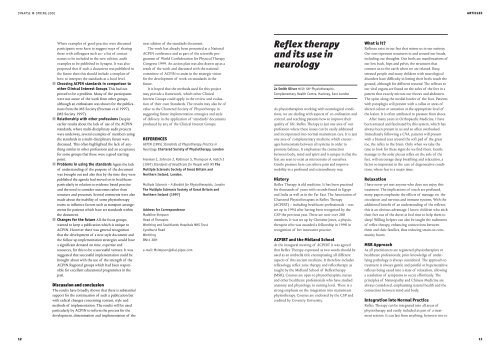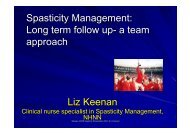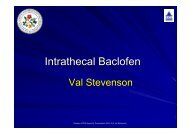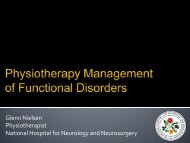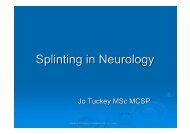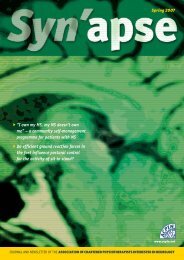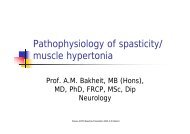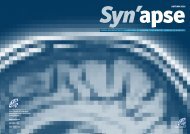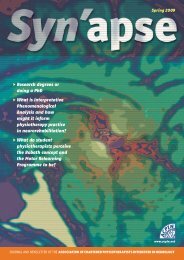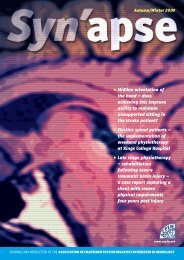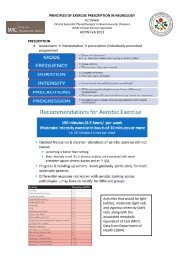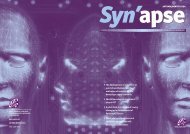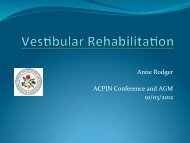Synapse SPRING 2000 - acpin
Synapse SPRING 2000 - acpin
Synapse SPRING 2000 - acpin
Create successful ePaper yourself
Turn your PDF publications into a flip-book with our unique Google optimized e-Paper software.
SYNAPSE ● <strong>SPRING</strong> <strong>2000</strong>ARTICLESWhere examples of good practice were discussedparticipants were keen to suggest ways of sharingthese with colleagues such as:- a list of contactnames to be included in the new edition, auditexamples to be published in <strong>Synapse</strong>. It was alsoproposed that if such a document was published inthe future then this should include a template ofhow to interpret the standards at a local level.■ Choosing ACPIN standards in comparison toother Clinical Interest Groups This had notproved to be a problem. Many of the participantswere not aware of the work from other groups,although an enthusiasm was shown for the publicationsfrom the MS Society (Freeman et al 1997),(MS Society 1997).■ Relationship with other professions Despiteearlier results about the lack of use of the ACPINstandards, where multi-disciplinary audit projectswere underway, several examples of members usingthe standards in a multi-disciplinary forum werediscussed. This often highlighted the lack of anythingsimilar in other professions and an acceptancefor some groups that these were a good startingpoint.■ Problems in using the standards Again the lackof understanding of the purpose of the documentwas brought out and also that by the time they werepublished the agenda had moved on in healthcareparticularly in relation to evidence based practiceand the need to consider outcomes rather thanstructure and processes. Several comments were alsomade about the inability of some physiotherapyteams to influence factors such as transport arrangementsfor patients which have set standards withinthe document.■ Changes for the future All the focus groupswanted to keep a publication which is unique toACPIN. However there was general recognitionthat the development of a new style document andthe follow up implementation strategies would havea significant demand on time, expertise andresources, for this to be a successful venture. It wassuggested that successful implementation could bebrought about with the use of the strength of theACPIN Regional groups which had been responsiblefor excellent educational programmes in thepast.Discussion and conclusionThe results have broadly shown that there is substantialsupport for the continuation of such a publication butwith radical changes concerning content, style andmethods of implementation. The results will be usedparticularly by ACPIN to inform the process for thedevelopment, dissemination and implementation of thenext edition of the standards document.The work has already been presented at a NationalACPIN conference and as part of the scientific programmeof World Confederation for Physical TherapyCongress 1999. An action plan was also drawn up as aresult of the work and discussed with the nationalcommittee of ACPIN to assist in the strategic visionfor the development of work on standards in thefuture.It is hoped that the methods used for this projectmay provide a framework, which other ClinicalInterest Groups could apply in the review and evaluationof their own Standards. The results may also be ofvalue to the Chartered Society of Physiotherapy insuggesting future implementation strategies and styleof delivery in the application of 'standards' documentsproduced by any of the Clinical Interest Groups.REFERENCESACPIN (1995) Standards of Physiotherapy Practice inNeurology Chartered Society of Physiotherapy, LondonFreeman J, Johnson J, Rollinson S, Thompson A, Hatch J(1997) Standards of Healthcare for People with MS TheMultiple Sclerosis Society of Great Britain andNorthern Ireland, London.Multiple Sclerosis – A Booklet for Physiotherapists, LondonThe Multiple Sclerosis Society of Great Britain andNorthern Ireland (1997)Address for CorrespondenceMadeline SimpsonHead of TherapiesWorthing and Southlands Hospitals NHS TrustLyndhurst RoadWorthingBN11 2DHe-mail: Msimpson@dial.pipex.comReflex therapyand its use inneurologyJo Smith Oliver MCSP, SRP Physiotherapist,Complementary Health Centre, Hackney, East LondonAs physiotherapists working with neurological conditions,we are dealing with aspects of co-ordination andcontrol, and teaching patients how to improve theirquality of life. Reflex Therapy is just one area of ourprofession where these issues can be easily addressedand incorporated into normal mainstream care. It is justone area of complementary medicine which encourageshomeostasis between all systems in order topromote balance. It emphasises the connectionbetween body, mind and spirit and is unique in that thefeet are seen to exist as microcosms of ourselves.Gentle pressure here can relieve pain and improvemobility in a profound and extraordinary way.HistoryReflex Therapy is old medicine. It has been practisedfor thousands of years with records found in Egyptand India as well as in the Far East. The Association ofChartered Physiotherapists in Reflex Therapy(ACPIRT) – including healthcare professionals – wasset up in 1994 after having been recognised by theCSP the previous year. There are now over 200members. It was set up by Christine Jones, a physiotherapistwho was awarded a fellowship in 1998 inrecognition of her innovative practice.ACPIRT and the Midland SchoolAt the inaugural meeting of ACPIRT it was agreedthat Reflex Therapy expressed as two words should beused as an umbrella title encompassing all differentaspects of this ancient medicine. It therefore includesreflexology, reflex zone therapy and reflextherapy astaught by the Midland School of Reflextherapy(MSR). Courses are open to physiotherapists, nursesand other healthcare professionals who have studiedanatomy and physiology to nursing level. There is astrong emphasis on the integration into mainstreamphysiotherapy. Courses are endorsed by the CSP andcredited by Coventry University.What is it?Reflexes exist in our feet that mirror us in our entirety.Our toes represent structures in and around our heads,including our thoughts. Our heels are manifestations ofour low back, hips and pelvis, the structures thatconnect us to the earth when we are relaxed. Busy,stressed people and many children with neurologicaldisorders have difficulty in letting their heels touch theground, although for different reasons! The reflexes toour vital organs are found on the soles of the feet in apattern that exactly mirrors our thorax and abdomen.The spine along the medial border of the foot. Patientswith paraplegia will present with a callus or areas ofaltered colour or sensation at the appropriate level ofthe lesion. It is often attributed to pressure from shoes.After many years in Orthopaedic Medicine, I havebeen amazed and fascinated by this system, which hasalways been present in us and so often overlooked.Immediately following a CVA, patients will presentwith a bruised area around the soft pad of the greattoe, the reflex to the brain. Only when we take thetime to look for these signs do we find them. Gentlemassage to the solar plexus reflex on the sole of thefeet, will encourage deep breathing and relaxation, afactor so important in the care of degenerative conditions,where fear is a major issue.RelaxationI have never yet met anyone who does not enjoy thistreatment. The implications of touch are profound,many papers emphasise the effects of massage on thecirculation and nervous and immune systems. With theadditional benefit of an understanding of the reflexesthis is an obvious advantage. I know children who sticktheir feet out of the duvet at bed time to help them tosleep! Willing helpers can also be taught the rudimentsof reflex therapy, enhancing connections betweenthem and their families, thus reducing strain on communityhours.MSR ApproachAs all practitioners are registered physiotherapists orhealthcare professionals, prior knowledge of underlyingpathology is always considered. The approach totreatment is always gentle and painful or hypersensitivereflexes being eased into a state of relaxation, allowinga resolution of symptoms to occur effortlessly. Theprinciples of Naturopathy and Chinese Medicine arealways considered, emphasising natural health and theconnection between mind and body.Integration into Normal PracticeReflex Therapy can be integrated into all areas ofphysiotherapy and easily included as part of a treatmentsession. It can last from anything, between two to1213


